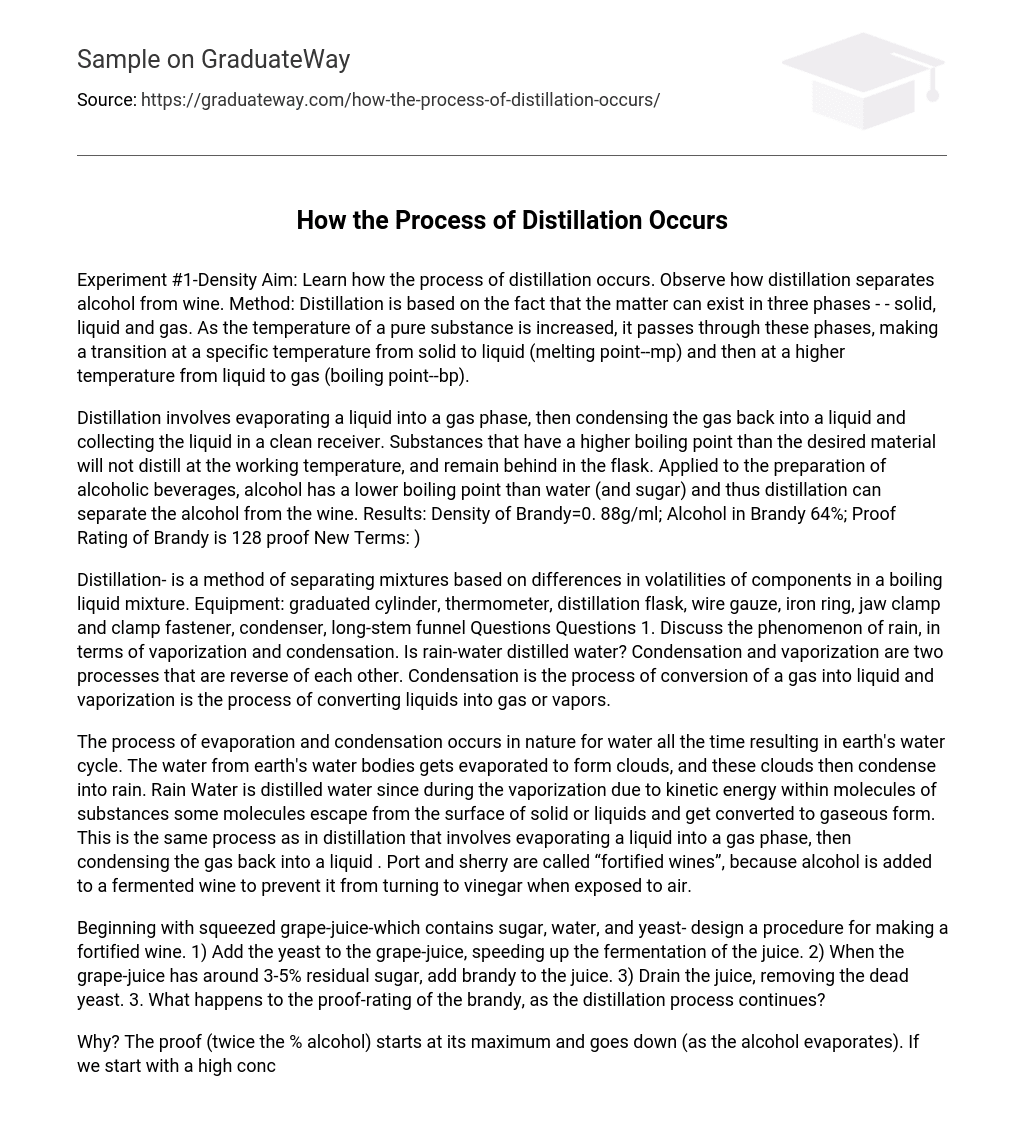Experiment #1-Density Aim: Learn how the process of distillation occurs. Observe how distillation separates alcohol from wine. Method: Distillation is based on the fact that the matter can exist in three phases – – solid, liquid and gas. As the temperature of a pure substance is increased, it passes through these phases, making a transition at a specific temperature from solid to liquid (melting point–mp) and then at a higher temperature from liquid to gas (boiling point–bp).
Distillation involves evaporating a liquid into a gas phase, then condensing the gas back into a liquid and collecting the liquid in a clean receiver. Substances that have a higher boiling point than the desired material will not distill at the working temperature, and remain behind in the flask. Applied to the preparation of alcoholic beverages, alcohol has a lower boiling point than water (and sugar) and thus distillation can separate the alcohol from the wine. Results: Density of Brandy=0. 88g/ml; Alcohol in Brandy 64%; Proof Rating of Brandy is 128 proof New Terms: )
Distillation- is a method of separating mixtures based on differences in volatilities of components in a boiling liquid mixture. Equipment: graduated cylinder, thermometer, distillation flask, wire gauze, iron ring, jaw clamp and clamp fastener, condenser, long-stem funnel Questions Questions 1. Discuss the phenomenon of rain, in terms of vaporization and condensation. Is rain-water distilled water? Condensation and vaporization are two processes that are reverse of each other. Condensation is the process of conversion of a gas into liquid and vaporization is the process of converting liquids into gas or vapors.
The process of evaporation and condensation occurs in nature for water all the time resulting in earth’s water cycle. The water from earth’s water bodies gets evaporated to form clouds, and these clouds then condense into rain. Rain Water is distilled water since during the vaporization due to kinetic energy within molecules of substances some molecules escape from the surface of solid or liquids and get converted to gaseous form. This is the same process as in distillation that involves evaporating a liquid into a gas phase, then condensing the gas back into a liquid . Port and sherry are called “fortified wines”, because alcohol is added to a fermented wine to prevent it from turning to vinegar when exposed to air.
Beginning with squeezed grape-juice-which contains sugar, water, and yeast- design a procedure for making a fortified wine. 1) Add the yeast to the grape-juice, speeding up the fermentation of the juice. 2) When the grape-juice has around 3-5% residual sugar, add brandy to the juice. 3) Drain the juice, removing the dead yeast. 3. What happens to the proof-rating of the brandy, as the distillation process continues?
Why? The proof (twice the % alcohol) starts at its maximum and goes down (as the alcohol evaporates). If we start with a high concentration of alcohol, we will get the azeotrope (95% alcohol, 5% water) for a while, then the concentration will decrease. 4. Commercial brandy is brown in color, while your “raw” brandy is colorless. Why the difference? Is brandy simply a water-alcohol mixture? After two distillations, the clear, colorless alcohol is given itsdistinctive nutty brown color and flavor by aging wood, often oak barrel.
The longer abrandy ages, the more refined its flavor is judged to be. Brandy is a spirit made by distilling grapes to a higher proof than they achieve as wine. Most is made from actual grape wine, though some may also be made from the pulpy mixture of stems and seeds left after grapes are pressed, and some is made from the fermented juices of fruits other than grapes 5. Using four well separated points from the table of density and percent alcohol by volume, make a density vs. percent alcohol by volume graph. Is the relationship between density and percent alcohol by volume a linear one?





